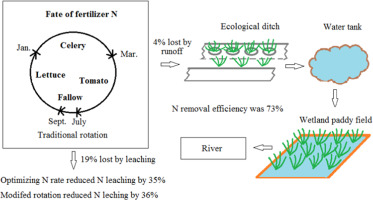当前位置:
X-MOL 学术
›
Sci. Total Environ.
›
论文详情
Our official English website, www.x-mol.net, welcomes your feedback! (Note: you will need to create a separate account there.)
Nitrogen discharge pathways in vegetable production as non-point sources of pollution and measures to control it
Science of the Total Environment ( IF 9.8 ) Pub Date : 2017-09-11 , DOI: 10.1016/j.scitotenv.2017.09.079 Ju Min , Weiming Shi
Science of the Total Environment ( IF 9.8 ) Pub Date : 2017-09-11 , DOI: 10.1016/j.scitotenv.2017.09.079 Ju Min , Weiming Shi

|
Discharge of nitrogen (N) from fertilizers applied to vegetables is becoming a serious environmental problem. In a field experiment involving a celery-tomato-fallow-lettuce rotation, leaching was the primary pathway of N loss (56.1 ± 0.4% of the total), followed, in descending order, by runoff (11.7 ± 0.3%), N2O emissions (1.6 ± 0.1%), and volatilization of ammonia (0.5 ± 0.1%). Decreasing the traditional dose of N by 40% in each growth season decreased N leaching by 22.3 ± 4.5, 39.8 ± 6.7, 40.3 ± 2.9 and 27.4 ± 3.6% in celery, tomato, fallow and lettuce seasons, respectively, without any yield loss, and modifying the rotation to include a leguminous crop reduced the N leaching by 72 ± 2, 40 ± 3, 24 ± 2 and 13 ± 1% in each season, respectively, without any economic impact. These measures decreased annual N leaching by 36 ± 4%. A combination of the eco-ditches and wetland paddy fields adjacent to the vegetable plot led to annual N removal efficiency of 73 ± 6% in runoff.
中文翻译:

蔬菜生产中氮的排放途径是面源污染及其控制措施
从施于蔬菜的肥料中释放氮(N)正成为一个严重的环境问题。在涉及芹菜-西红柿-莴苣轮作的田间试验中,淋溶是氮素流失的主要途径(占总数的56.1±0.4%),其次是降水(11.7±0.3%),N 2O排放(1.6±0.1%),氨气挥发(0.5±0.1%)。在每个生长季节将传统氮素剂量减少40%,在芹菜,番茄,休耕和生菜季节,氮素淋失分别减少22.3±4.5、39.8±6.7、40.3±2.9和27.4±3.6%,而没有任何产量损失,调整轮作使其包括豆科作物,则每个季节的氮淋失分别减少72±2、40±3、24±2和13±1%,而没有任何经济影响。这些措施使年度氮淋失减少了36±4%。邻近菜地的生态沟和湿地稻田相结合,导致径流年除氮效率为73±6%。
更新日期:2017-09-13
中文翻译:

蔬菜生产中氮的排放途径是面源污染及其控制措施
从施于蔬菜的肥料中释放氮(N)正成为一个严重的环境问题。在涉及芹菜-西红柿-莴苣轮作的田间试验中,淋溶是氮素流失的主要途径(占总数的56.1±0.4%),其次是降水(11.7±0.3%),N 2O排放(1.6±0.1%),氨气挥发(0.5±0.1%)。在每个生长季节将传统氮素剂量减少40%,在芹菜,番茄,休耕和生菜季节,氮素淋失分别减少22.3±4.5、39.8±6.7、40.3±2.9和27.4±3.6%,而没有任何产量损失,调整轮作使其包括豆科作物,则每个季节的氮淋失分别减少72±2、40±3、24±2和13±1%,而没有任何经济影响。这些措施使年度氮淋失减少了36±4%。邻近菜地的生态沟和湿地稻田相结合,导致径流年除氮效率为73±6%。



























 京公网安备 11010802027423号
京公网安备 11010802027423号